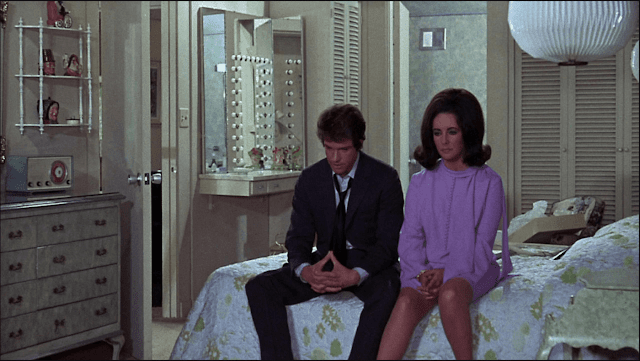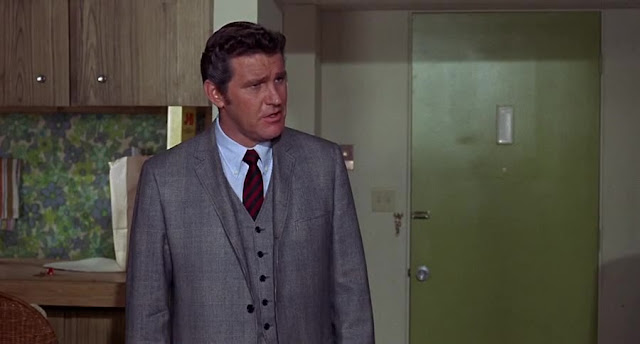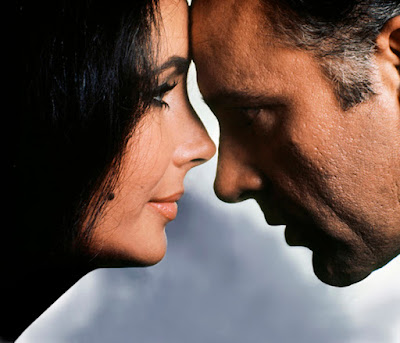 |
| One of Elizabeth Taylor's directors accurately if unkindly said that "Elizabeth's face is her fortune, but her body belongs to somebody else!" Yes, but what a face! |
 |
| Warren Beatty & Elizabeth Taylor's rapport is one of the few bright spots in 1970's romantic drama,"The Only Game in Town." |
A life-long Elizabeth Taylor fan, there are
not many ET films that I won't repeat-watch, but The Only Game in Town is one. I found a great print of this flick
recently, so I gave it a second try. Once again, I was bored to tears.
The Only Game in Town is basically a two-character
Broadway play turned movie that was filmed late 1968/early '69, but dumped into
release January, 1970! For the last time, The
Only Game in Town won Elizabeth Taylor her highest salary, 1.25 million
dollars. As in A Place in the Sun and
Giant, Taylor got favored director
George Stevens, but as with Monty Clift and James Dean, Taylor got a hot method
leading man, Warren Beatty, fresh off Bonnie
and Clyde.
 |
| One of the few scenes of location shooting, the opening credits of ET strolling home. |
Game was set in Las Vegas,
but filmed mostly in Paris. Why? So Taylor could be near Richard Burton, where
he was filming his dud, Staircase. There was some exterior
filming in Vegas. And if nearly all the film takes place in her character's
apartment or with Beatty in casinos, what was the difference?
 |
| The one-night stand between Fran & Joe becomes something deeper in "The Only Game in Town." |
The real problem, as often the case with
movies that bomb big, was the script. The
Only Game in Town was first a poorly reviewed Broadway flop. Here, Warren
Beatty's Joe is an addicted gambler and Taylor's Fran is an aging showgirl,
waiting for her married lover to come through with a proposal. Then Joe and
Fran hook up, start to fall for each other, and fight and make up along the way.
That’s it.
 |
| ET doesn't even do jazz hands as the aging showgirl in "The Only Game in Town." |
The other big problem with Game is both stars are miscast. Warren
Beatty was far too young and breezy to be believable as a world-weary, down on
his luck gambler. Frank Sinatra was first choice, but left when Taylor's
emergency hysterectomy took a long recovery, and he left the project. Elizabeth
Taylor, as many viewers noted, was too short and plump to play a Vegas
showgirl. The perfect team would have been Sinatra and Shirley MacLaine, as an
extension of the roles they played in Some
Came Running a decade before.
 |
| Big stars, with even bigger hairstyles, in "The Only Game in Town." |
What is unfair from today’s viewpoint is how
many critics and film fans have dumped all
the blame on Taylor. Many commented that Liz looked like Beatty's mother. Taylor
did look matronly with her shapeless
minis and with football helmet wigs. Some of this was the era’s style, none of which
suited petite and plump Elizabeth. However, at 36, her face still looks quite
lovely here. And while Beatty was boyish at 31, but he doesn't look like the
kid from Splendor in the Grass. With Heaven Can Wait eight years later,
Warren at 40 would start giving himself the soft focus treatment. Even if
Taylor looks older, I think of all the prematurely aged actors like Gable,
Cooper, Crosby, Stewart, and Astaire, acting opposite new stars like Audrey, Grace,
or Leslie Caron— all a quarter of a century younger! And many of young Elizabeth’s
co-stars were 15 to 20 years older, too. Here, Elizabeth hardly looked like a
hag.
 |
| This profile photo of Elizabeth Taylor & Warren Beatty reminds me of a famous pic of ET & Richard taken five years before. Burton admitted concern over Beatty's charms. |
Off-screen, Taylor and Beatty certainly had a
mutual admiration society, to the point where hubby Richard Burton admitted
concern. When Elizabeth said she thought of Warren as a brother, Burton
replied, "Yes, but I worry about incest!" Taylor later told Barbara
Walters that she rated Warren an 11 on a scale of one to 10. Elizabeth called
Warren “Warren Beauty;” my nickname for him is “Sleeping Beatty!” I've always
thought of Beatty as an artsy George Hamilton, but his wry charm can appeal.
Beatty commented much later that he thought Elizabeth had the most beautiful
face he’d ever seen and that he never
met an actress less interested in acting, at that point.
More than Taylor’s physical attributes, it’s
her intrusive fame that distracts. What showgirl who’s a homebody that watches
old movies would constantly be changing outfits, wigs, and wear full makeup
just to sit around her apartment? Or wake up wearing tons of jewelry? Scenes
with hefty Liz asking to be carried by Beatty into the bedroom, or questioning
the size of a diamond ring, all seems like begging for ridicule. Also, has
anyone ever noticed how much Kim Novak’s more believable Third Girl from the Left resembles The Only Game in Town? Both feature an aging showgirl, schmuck
boyfriend, and younger beau.
 |
| Who wears their jewelry to bed? Elizabeth Taylor in "The Only Game in Town!" |
Despite Taylor being overly dramatic in the big
scenes, she’s good in her brittle banter with Beatty. I like the scene where
they twit each other by singing to each other from different rooms. While
Warren Beatty is not one of my favorite actors, he does show a flair for humor.
His youth plays against him, where his constant jokes doesn't seem like a
defense mechanism of an older guy keeping reality at bay, but that of an
immature jerk. Still, in his big scene, where he finally admits that he's in
love with Fran, teary-eyed and all, Beatty’s genuinely touching.
 |
| Warren Beatty's great as Joe declares his love for Fran in "The Only Game in Town." |
George Stevens was known for his character-driven,
methodic style. You come to know the characters here, but after Fran turns down
her long-time beau's proposal, the movie has nowhere else to go. This was
Stevens’ last film and his work had become lethargic, as in 1965’s The Greatest Story Ever Told.
 |
| The only thing more boring than Fran's married lover finally agreeing to put a ring on it is staring at the avocado green decor! |
Vicki Tiel and Mia Fonssagrives were Taylor’s
designer friends. Their clothes represent Taylor's worst style period. Yes, ET
was not a '60s chick. But they really couldn't think of any other way of
dressing her than to throw her in tent-like minis? Thankfully, they stick to
solid colors, which makes ET's coloring pop. I'm sure hairdresser Alexandre of
Paris knew the drill of what Liz wanted, but couldn't he have fashioned her
wigs not to look like bowling balls? One critic correctly commented that Taylor
looked like the dancing tomato from the old drive-in movie ads, in rounded ‘dos
and muumuu minis, with her short legs sticking out.
 |
| Liz looks lovely in an indigo blue boating top... |
 |
| I guess ET's fancy designers forgot that stripes aren't exactly slimming when your star is short and chubby. And Elizabeth Taylor's hat is nearly as tall as she is! |
Taylor hadn’t been slim on film since Cat on a Hot Tin Roof, but didn’t start
getting called out on it until The
Sandpiper. I recall Rex Reed’s quote about ET in Game, that she looked like “the Goodyear Blimp pumped full of
Chasen’s chili.” The unkind comments on her weight reached fever pitch in the
late ‘70s as a fat Republican wife, and Joan Rivers led the pack. It’s odd that
in our current PC culture, some show biz writers or bloggers think it’s funny
to make Liz Taylor fat or drunk jokes, while clutching their pearls over the
same criticism of today’s stars.
The Only Game in Town was an attempt at the kind of mainstream movie
Elizabeth Taylor used to make. Critic Pauline Kael aptly wrote that “after the
initial pleasure of seeing Elizabeth looking prettier than she has in years, Game is a sluggish star vehicle of the
bad old days.” I don’t think anyone
involved here was at their best, and watching this Game once is definitely enough.
The scene where Joe wins big, then loses bigger, is one of the best from "The Only Game in Town." Interesting that Beatty began the decade starring with Vivien Leigh & ended with Elizabeth Taylor.
Here’s my post on the 10 year anniversary of Elizabeth Taylor’s passing: https://ricksrealreel.blogspot.com/2021/03/reflections-of-life-long-elizabeth.html
FYI: I put all the movie overflow on my public FB movie
page.
Check it out & join! https://www.facebook.com/groups/178488909366865/
 |
| Is this the apricot scarf Carly Simon wrote about in "Your So Vain?" |


















